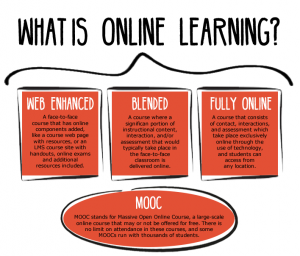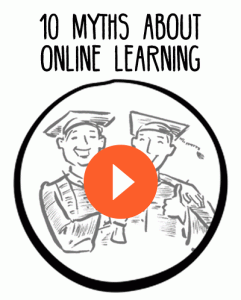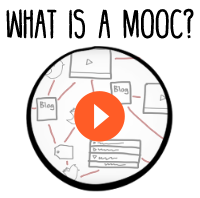Discover Online Learning
When the concept of online learning is mentioned, people think and talk about many different things. Within different contexts, online learning can actually be designed, developed, and delivered in many different ways. And, the practice of “teaching online” can take on just as many different meanings.
Here, at SUNY Online Teaching, when we talk about teaching online courses, we are generally talking about fully online courses with a specific approach to creating an interactive learner-centered asynchronous online teaching and learning environment. The asynchronous online environment enables online learners to take classes at any time from any place.
In an asynchronous online course, learning materials, interactions, assignments, assessments, and feedback can be accessed and completed at any time. Instructors and learners access the online course at their convenience, within a set schedule established by the instructor. Some activities might take place off-line, specific time frames and due dates are established, but the distinguishing characteristic is that there is no requirement for everyone to be in the same place online at the same time. At SUNY online courses have start and end dates, an online instructor, and a cohort of online classmates that interact with each other and with the course content to achieve the specific objectives of the course.
It might be helpful to see online education on a continuum from face-to-face to fully online, and to consider approaches that can be integrated into face-to-face courses as you explore the possibilities and your interest in teaching online.

Web-Enhanced: A web-enhanced course is a face-to-face course that has online components added, like a course web page with resources, or a learning management system (LMS) course site with handouts, online exams and additional resources included. Instructors and students meet in a physical classroom space at a specified time, but resources are available at any time online. Note: A web-enhanced course can be a good way to get started in online teaching because it can give you an idea of how learners interact online, and lets you take time to explore available LMS tools while still teaching in the face-to-face environment.
Blended: A blended online class combines the components of a face-to-face course, and an online course with the instructor, balancing out the time students spend in both places. In a blended course, students might meet face-to-face once a week and spend the rest of the week online, exploring readings, participating in asynchronous discussions, completing projects, etc. To be considered a blended course some combination of content, interaction, or assessment would need to take place online and some needs to be in the classroom. Note: Blended courses reduce the amount of time spent sitting physically in the face-to-face classroom with commensurate time spent online.
Hybrid: Hybrid is another term commonly used to describe blended online courses. It is typically up to the instructor to determine the best combination of face-to-face and online content, interaction, and assessment to meet the course learning goals and objectives.
Fully Online (Asynchronous): A fully-online asynchronous course consists of content, learning activities, interactions, assessments, and feedback that take place primarily online – though not at the same time. In a fully-online course, students and faculty have the opportunity to teach and learn from any place at any time, yet are engaged in a shared learning experience where the technology is leveraged to promote student mastery of skills and to help meet course goals and objectives. Asynchronous activities can consist of instructor lectures, student presentations, simulations, demonstrations, guest speakers, etc. Check out a demo course, and the online navigator for SUNY online programs and courses.
Fully Online (Synchronous): When synchronous components are introduced to an online course, then time is set aside for the students and instructor to meet online via webinar applications (inside or outside of the LMS). Synchronous sessions can consist of instructor lectures, student presentations, guest speaker sessions, and the like. Most SUNY online courses do not include required synchronous sessions. Note: Within online courses, some instructors do include optional synchronous sessions for scheduled online office hours, and other events.
MOOCs: MOOC stands for Massive Open Online Course, a model for presenting and delivering instructional course materials and content online to anyone. There are a couple of varieties of types of MOOCs and platforms, and they are generally self-paced large-scale online courses that may or may not be offered for free with no limit on attendance. Some MOOCs run with thousands of students. Check out some SUNY MOOCs and the SUNY agreement with Coursera.
Check out the excellent YouTube video explanation of what MOOCs are, by Dave Cormier:
As you continue your exploration of teaching online, you will learn more about each of these approaches, and ways that you can benefit from the design, development, and delivery approaches and technologies that support each of them.
 MYTHS ABOUT ONLINE LEARNING
MYTHS ABOUT ONLINE LEARNING
Teaching online is more than just taking your classroom materials and putting them up online – it is a reconceptualization of how you achieve your learning objectives.
Take a quick look at ten common myths that you may have come across while exploring your interest in teaching online.

MORE TO EXPLORE
What is Online Learning?
This blog post from Tony Bates provides a good introduction to online learning, and offers additional resources to explore for more information related to his book, Teaching in a Digital Age.
http://www.tonybates.ca/2016/07/15/online-learning-for-beginners-1-what-is-online-learning/
The Blended Learning ToolKit (BlendKit)
Primarily focused on Blended Learning, this site offers an extensive collection of resources related to designing, developing, and delivering blended courses.
https://blended.online.ucf.edu/blendkit-course/
Online Learning Insights
This blog covers a wide range of topics related to online learning, written by Instructional Designer and Educator, Debbie Morrison.
https://onlinelearninginsights.wordpress.com/
SUNY MOOC/Coursera
Explore how SUNY campuses have the opportunity to work with Coursera to deliver courses to students within SUNY or across the globe.
https://online.suny.edu/mooc-coursera-faq/
